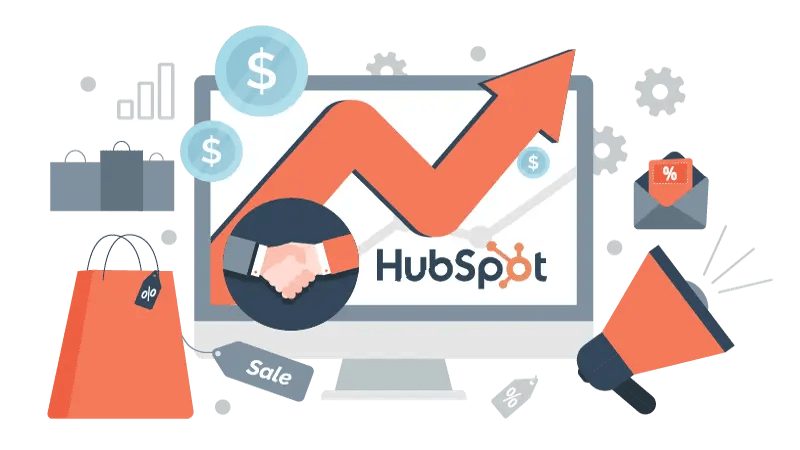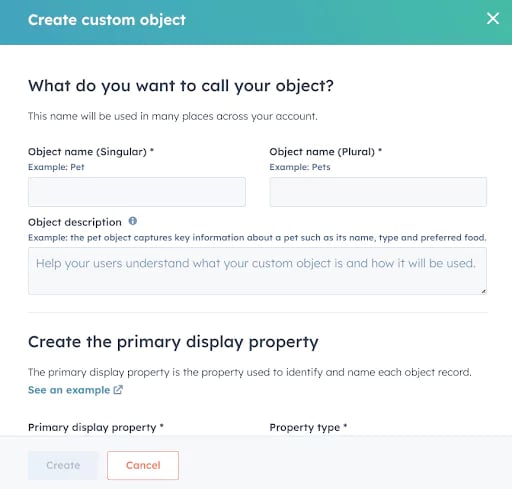HubSpot Custom Objects verstehen: Tipps zur effektiven Nutzung
In einer Welt, in der Einheitslösungen nicht ausreichen, erweisen sich benutzerdefinierte Objekte als der Schlüssel zur Erschließung eines maßgeschneiderten Datenmanagements innerhalb des HubSpot-Ökosystems. Vom Verständnis ihrer Kerndefinition bis hin zu fortgeschrittenen Strategien und der Bewältigung von Herausforderungen - dieser Leitfaden vermittelt Ihnen das Wissen, um das volle Potenzial von HubSpot Custom Objects zu nutzen.

Was sind HubSpot Custom Objects?
In HubSpot fungieren benutzerdefinierte Objekte als benutzerdefinierte Datenstrukturen, die die Möglichkeiten der Plattform über die Standardobjekte wie Kontakte, Unternehmen und Geschäfte hinaus erweitern. Sie ermöglichen es Unternehmen, benutzerdefinierte Datentypen zu erstellen, die auf ihre Bedürfnisse und Arbeitsabläufe abgestimmt sind. Jedes benutzerdefinierte Objekt verfügt über einzigartige Eigenschaften, Assoziationen mit anderen Objekten und Funktionalitäten innerhalb von HubSpot CRM, so dass Sie Ihre Datenverwaltung an Ihre individuellen Geschäftsanforderungen anpassen können.
Im Wesentlichen handelt es sich um benutzerdefinierte Datenbanktabellen, die Sie innerhalb der Plattform erstellen. Jede Tabelle, die durch ein benutzerdefiniertes Objekt dargestellt wird, umfasst einzelne Spalten, die als benutzerdefinierte Eigenschaften bezeichnet werden. Sie definieren diese Eigenschaften auf der Grundlage der spezifischen Datenpunkte, die Sie verfolgen müssen. Stellen Sie sich die Eigenschaften als Datenkategorien vor, die Sie erfassen möchten, z. B. "Projektphase", "Produktfarbe" oder "Webinar-Registrierungsdatum".
Obwohl benutzerdefinierte Objekte eindeutiger sind als andere HubSpot-Elemente wie Kontakte, Unternehmen und Deals, existieren sie nicht isoliert. Stattdessen können benutzerdefinierte Objekte Beziehungen zu diesen Elementen herstellen, die eine Datenaggregation und Querverweise ermöglichen und eine ganzheitliche Sicht auf Ihre Geschäftsabläufe bieten. Stellen Sie sich vor, Sie verknüpfen Ihr benutzerdefiniertes Objekt "Veranstaltungsteilnehmer" mit einzelnen Kontaktdatensätzen. So können Sie die Kommunikation nach der Veranstaltung auf der Grundlage von Anwesenheitsdaten und persönlichen Präferenzen anpassen.
Es gibt mehrere zwingende Gründe, benutzerdefinierte Objekte in Ihre HubSpot-Strategie einzubinden:
-
Anpassung an einzigartige Daten: Benutzerdefinierte Objekte sind eine effektive Lösung für die Verwaltung von Daten, die sich nicht nahtlos in den Standardobjektrahmen von HubSpot einfügen. Auf diese Weise können Sie Informationen erfassen und organisieren, die für Ihren Betrieb wichtig sind, aber nicht in die traditionellen Kategorien von Kontakten, Unternehmen oder Geschäftsabschlüssen passen.
-
Organisieren Sie Informationen: Benutzerdefinierte Objekte bieten spezielle Bereiche für die Nachverfolgung spezifischer Datentypen und verbessern die Organisation und Zugänglichkeit. Sie können benutzerdefinierte Strukturen für Projektmeilensteine, Produktinventare, Veranstaltungsregistrierungen, Kundenfeedback oder andere für Ihr Unternehmen wichtige Daten erstellen.
-
Automatisieren Sie Prozesse: Sie können Workflows und Automatisierungen auf der Grundlage von Änderungen in benutzerdefinierten Objektdaten auslösen, um Abläufe zu rationalisieren und manuelle Aufgaben zu reduzieren. So können Sie automatische Benachrichtigungen, Aufgabenzuweisungen oder andere Aktionen auf der Grundlage bestimmter Ereignisse oder Meilensteine innerhalb Ihrer benutzerdefinierten Objekte einrichten.
-
Gewinnen Sie Einblicke: Benutzerdefinierte Objekte ermöglichen die Erstellung von benutzerdefinierten Berichten und Dashboards zur Analyse von Trends und Mustern, was zu einer besseren Entscheidungsfindung führt. Auf diese Weise können Sie wertvolle Erkenntnisse aus Ihren individuellen Daten gewinnen und ein tieferes Verständnis für Ihre Abläufe, Kundeninteraktionen und verbesserungswürdige Bereiche gewinnen.
-
Skalieren Sie mit Ihrem Unternehmen: Sie passen sich den sich entwickelnden Geschäftsanforderungen an, indem sie im Laufe der Zeit neue Eigenschaften und Funktionalitäten hinzufügen. Das bedeutet, dass Ihre benutzerdefinierten Objekte mit Ihrem Unternehmen wachsen und sich weiterentwickeln können, so dass Ihr CRM stets auf Ihre sich ändernden Datenanforderungen abgestimmt ist.
Hauptmerkmale und Funktionalität von benutzerdefinierten Objekten
Das Verständnis der wichtigsten Merkmale und Funktionen der benutzerdefinierten Objekte von HubSpot ist von entscheidender Bedeutung für die Maximierung ihrer Vorteile bei der Datenorganisation und -verwaltung.
1. Flexibilität und Anpassung
Eines der herausragenden Merkmale der benutzerdefinierten HubSpot-Objekte ist ihre unvergleichliche Flexibilität. Im Gegensatz zu Standardobjekten mit festen Strukturen können Benutzer bei benutzerdefinierten Objekten ihre Datenfelder definieren und das CRM an ihre individuellen Bedürfnisse anpassen. Diese Flexibilität erstreckt sich auch auf die Erstellung von Beziehungen, die es den Benutzern ermöglichen, Verbindungen zwischen benutzerdefinierten Objekten und anderen HubSpot-Tools herzustellen. Diese Anpassungsfähigkeit stellt sicher, dass Unternehmen ihre Datenstrukturen genau auf ihre betrieblichen Anforderungen zuschneiden können, was einen strafferen und effizienteren Arbeitsablauf fördert.
2. Beziehungs-Mapping
Die Möglichkeit, Beziehungen abzubilden, ist ein entscheidender Faktor für die Datenorganisation. Die benutzerdefinierten Objekte von HubSpot bieten einen umfassenden Rahmen für Benutzer, um Verbindungen zwischen verschiedenen Dateneinheiten herzustellen. Diese Funktion ist für Unternehmen mit komplexen Prozessen von unschätzbarem Wert, da sie eine klare und organisierte Ansicht der Beziehungen zwischen verschiedenen Datenpunkten ermöglicht. Ganz gleich, ob es um die Verfolgung von Kundeninteraktionen, die Verwaltung von Vertriebspipelines oder die Optimierung von Marketingkampagnen geht, die Relationship-Mapping-Funktionalität der benutzerdefinierten Objekte gewährleistet eine ganzheitliche Sicht auf die Daten und trägt zu einer fundierteren Entscheidungsfindung bei.
3. Integration mit anderen HubSpot-Tools
Benutzerdefinierte Objekte sind so konzipiert, dass sie sich nahtlos in andere HubSpot-Tools integrieren lassen und ein zusammenhängendes Ökosystem bilden. Ob es sich um die Synchronisierung mit dem CRM, der Marketingautomatisierung oder den Vertriebstools handelt, benutzerdefinierte Objekte gewährleisten eine einheitliche Datenerfahrung auf der gesamten Plattform. Diese Integrationsfunktion verbessert die Zusammenarbeit zwischen verschiedenen Teams innerhalb eines Unternehmens, bricht Datensilos auf und fördert einen kooperativen und fundierten Ansatz für die Entscheidungsfindung. Das Ergebnis ist ein synchronisierter und effizienter Datenfluss, der es Unternehmen ermöglicht, mehr Wert aus ihrer HubSpot-Investition zu schöpfen.
Einrichten von HubSpot Custom Objects
Die Einrichtung von benutzerdefinierten HubSpot-Objekten ist entscheidend für die Freisetzung ihres Potenzials für ein rationalisiertes Datenmanagement und verbesserte Geschäftsprozesse. Diese Schritt-für-Schritt-Anleitung führt Sie durch den Prozess und gewährleistet eine reibungslose und effektive Implementierung in Ihrem HubSpot-Ökosystem.
Erstellen von benutzerdefinierten Objekten
-
Navigieren Sie zu Ihrem HubSpot-Dashboard und öffnen Sie das Menü "Einstellungen".
-
Wählen Sie unter der Registerkarte "Objekte" die Option "Benutzerdefinierte Objekte" und klicken Sie auf "Benutzerdefiniertes Objekt erstellen".
-
Geben Sie Ihrem benutzerdefinierten Objekt einen eindeutigen und beschreibenden Namen, der der Art der Daten entspricht, die Sie verwalten möchten.
Definieren Sie Eigenschaften und benutzerdefinierte Felder
-
Sobald Ihr benutzerdefiniertes Objekt erstellt ist, müssen Sie seine Eigenschaften und benutzerdefinierten Felder definieren.
-
Bestimmen Sie die spezifischen Datenpunkte, die Sie innerhalb des benutzerdefinierten Objekts erfassen und organisieren möchten.
-
Erstellen Sie benutzerdefinierte Felder für jeden Datenpunkt und wählen Sie je nach Art der Informationen Feldtypen wie Text, Datum oder Dropdowns.
Benennungskonventionen und Organisation
-
Legen Sie eine einheitliche Namenskonvention für Ihre benutzerdefinierten Objekte und Felder fest. Dies gewährleistet Klarheit und einfache Referenz bei der Skalierung Ihrer Daten.
-
Gruppieren Sie zusammengehörige benutzerdefinierte Felder in Abschnitten, um die Organisation zu verbessern und die Benutzerfreundlichkeit zu erhöhen.
-
Berücksichtigen Sie die zukünftige Skalierbarkeit Ihrer Datenstruktur, wenn Sie Eigenschaften definieren und potenzielles Wachstum und Entwicklung Ihrer Geschäftsanforderungen vorhersehen.
Die Einrichtung von benutzerdefinierten HubSpot-Objekten ist benutzerfreundlich und ermöglicht es Unternehmen, ihr CRM an ihre individuellen Datenanforderungen anzupassen. Denken Sie bei der Einrichtung daran, wie wichtig eine präzise Nomenklatur und eine durchdachte Organisation sind, um eine nahtlose Benutzererfahrung zu ermöglichen.

Tipps für effektives Management
-
Identifizieren Sie die wichtigsten Datenelemente: Bevor Sie benutzerdefinierte Objekte erstellen, sollten Sie die wichtigsten Datenelemente identifizieren, die für Ihre Geschäftsprozesse entscheidend sind. Dieser proaktive Ansatz stellt sicher, dass Ihre benutzerdefinierten Objekte genau auf Ihre Datenverwaltungsanforderungen abgestimmt sind.
-
Nutzen Sie die HubSpot Academy: Die HubSpot Academy bietet wertvolle Ressourcen, darunter Tutorials und Dokumentationen, die Benutzer durch den Prozess der Einrichtung benutzerdefinierter Objekte führen. Nutzen Sie diese Ressourcen, um Ihr Verständnis zu verbessern und die Einrichtung zu optimieren.
-
Testen und iterieren: Führen Sie gründliche Tests durch, um sicherzustellen, dass das System nach der Einrichtung von benutzerdefinierten Objekten wie vorgesehen funktioniert. Iterieren Sie bei Bedarf und verfeinern Sie Ihre Datenstruktur auf der Grundlage der realen Nutzung und des Benutzerfeedbacks.
-
Benutzerschulung einrichten: Stellen Sie sicher, dass Ihr Team mit der Verwendung von benutzerdefinierten Objekten gut vertraut ist. Bieten Sie Schulungssitzungen an, um die Benutzer mit der neuen Datenstruktur, den benutzerdefinierten Feldern und den damit verbundenen Arbeitsabläufen vertraut zu machen.
-
Regelmäßige Audits und Optimierung: Ihre Datenanforderungen werden sich weiterentwickeln. Führen Sie regelmäßige Audits Ihrer benutzerdefinierten Objekte durch und überprüfen Sie die Datenqualität und -relevanz. Optimieren Sie die Einrichtung auf der Grundlage der sich entwickelnden Geschäftsanforderungen, um eine maximale Effizienz zu gewährleisten.
Mit diesen Schritten und praktischen Tipps können Unternehmen die benutzerdefinierten Objekte von HubSpot präzise einrichten und sicherstellen, dass ihr CRM nahtlos auf ihre individuellen Datenverwaltungsanforderungen abgestimmt ist. Die effektive Nutzung von benutzerdefinierten Objekten beginnt mit einer soliden Grundlage und macht die Einrichtungsphase zu einer entscheidenden Komponente ihrer Integration in Ihr HubSpot-Ökosystem.
Benötigen Sie Hilfe beim Onboarding zu HubSpot oder bei der Migration Ihres CRM?
Erweiterte Strategien
Mit zunehmender Reife in der Verwendung von benutzerdefinierten HubSpot-Objekten können Benutzer fortgeschrittene Strategien einsetzen, um noch mehr Nutzen aus dieser dynamischen Funktion zu ziehen. Hier erkunden wir Taktiken, die über die Grundlagen hinausgehen und das volle Potenzial von benutzerdefinierten Objekten für verbesserte Effizienz und strategische Erkenntnisse freisetzen.
Automatisierung und Workflow
-
Auslöserbasierte Automatisierung: Implementieren Sie Automatisierungsworkflows, die durch bestimmte Aktionen innerhalb benutzerdefinierter Objekte ausgelöst werden. Automatisieren Sie zum Beispiel Folgeaktionen, wenn ein bestimmtes benutzerdefiniertes Feld aktualisiert wird.
-
Integration mit HubSpot-Workflows: Integrieren Sie benutzerdefinierte Objekte nahtlos in HubSpot-Workflows, um ein einheitliches und automatisiertes Datenmanagementsystem zu schaffen.
Benutzerdefinierte Objekte in HubSpot CRM
-
Integration von benutzerdefinierten Objekten in CRM-Datensätze: Stellen Sie Verbindungen zwischen benutzerdefinierten Objekten und Standard-CRM-Datensätzen her, um einen umfassenden Überblick über Kundeninteraktionen zu erhalten.
-
Erweiterte Berichte mit CRM und benutzerdefinierten Objekten: Kombinieren Sie CRM- und benutzerdefinierte Objektdaten, um detaillierte Berichte zu erstellen und so Einblicke in das Kundenverhalten und die Präferenzen zu erhalten.
Integration von benutzerdefinierten Objekten in Analysen und Berichte
-
Metriken für benutzerdefinierte Objekte: Definieren und verfolgen Sie benutzerdefinierte Metriken in benutzerdefinierten Objekten, um bestimmte Leistungskennzahlen (KPIs) zu messen.
-
Erweiterte Berichts-Dashboards: Erstellen Sie benutzerdefinierte Dashboards durch die Integration von benutzerdefinierten Objektdaten, die einen ganzheitlichen Überblick über Ihre Geschäftsprozesse bieten.
Benutzerdefinierte Objekte sind nicht nur Standardtools, sondern eine Investition in die Zukunft Ihrer HubSpot-Erfahrung. Sie überwinden die Grenze zwischen vordefinierten Strukturen und Ihren individuellen Datenanforderungen und eröffnen Ihnen eine Welt des maßgeschneiderten Datenmanagements, optimierter Workflows und umsetzbarer Erkenntnisse. Indem Sie ihre Flexibilität nutzen, können Sie ein HubSpot-Ökosystem aufbauen, das Ihre Geschäftslogik perfekt widerspiegelt und zu greifbaren Ergebnissen führt.
Für den Zugriff auf benutzerdefinierte Objekte ist ein Abonnement auf Unternehmensebene erforderlich, sei es HubSpot Content Hub, Marketing Hub Enterprise, Operations Hub, Sales Hub Enterprise oder HubSpot Service Hub Enterprise.
Dieser Beitrag ist auch verfügbar in:
- Englisch: Understanding HubSpot Custom Objects: Tips for Effective Use
- Spanisch: Objetos personalizados HubSpot: ¡Úsalos al máximo!
- Französisch: Optimisez l'utilisation des objets personnalisés HubSpot : Guide
- Italienisch: Oggetti Personalizzati in HubSpot: Guida Completa per un Uso Efficace
- Rumänisch: Obiectele personalizate HubSpot: Ghid pentru utilizare eficientă
- Chinesisch: 了解 HubSpot 自定义对象:有效使用技巧









Hinterlasse einen Kommentar